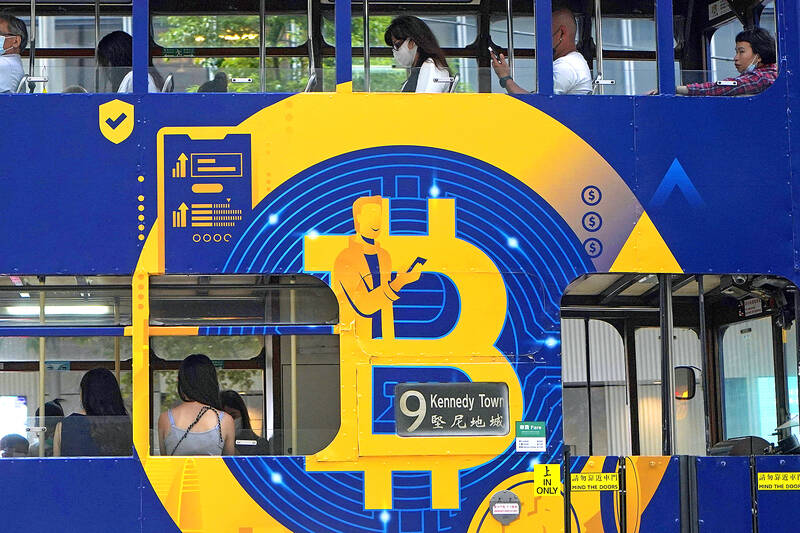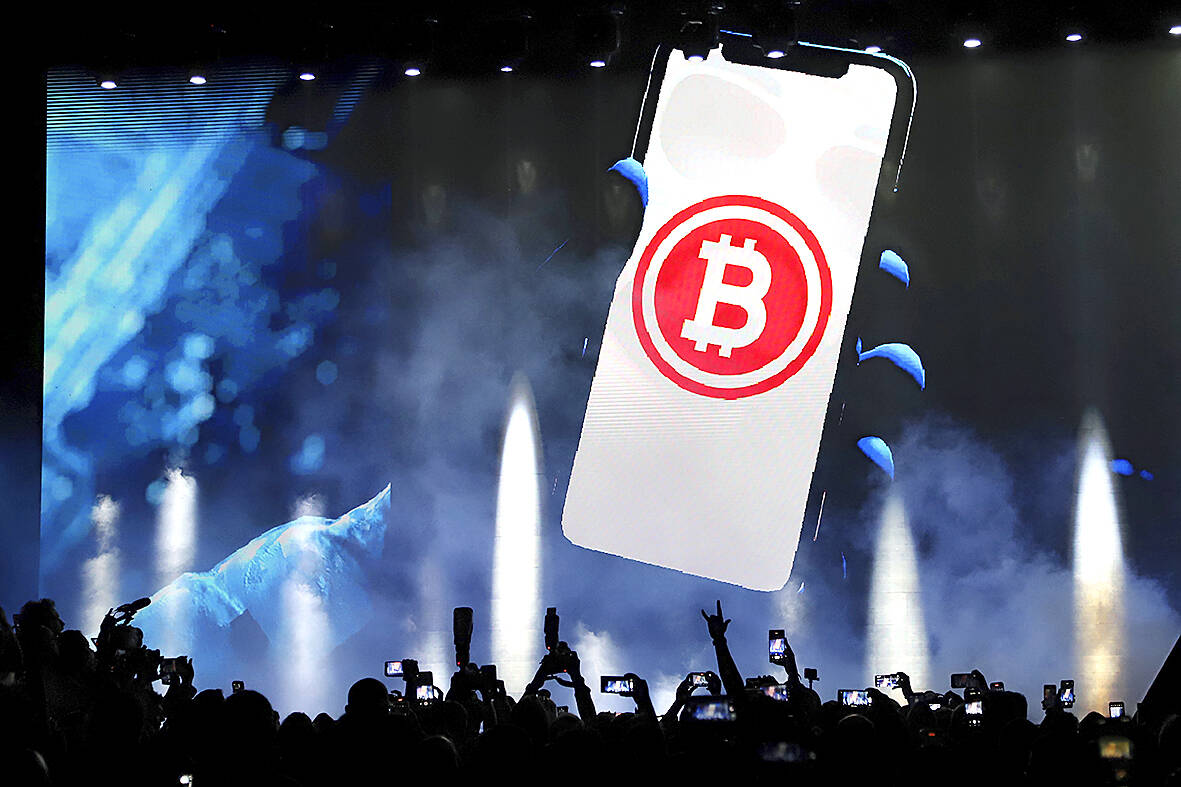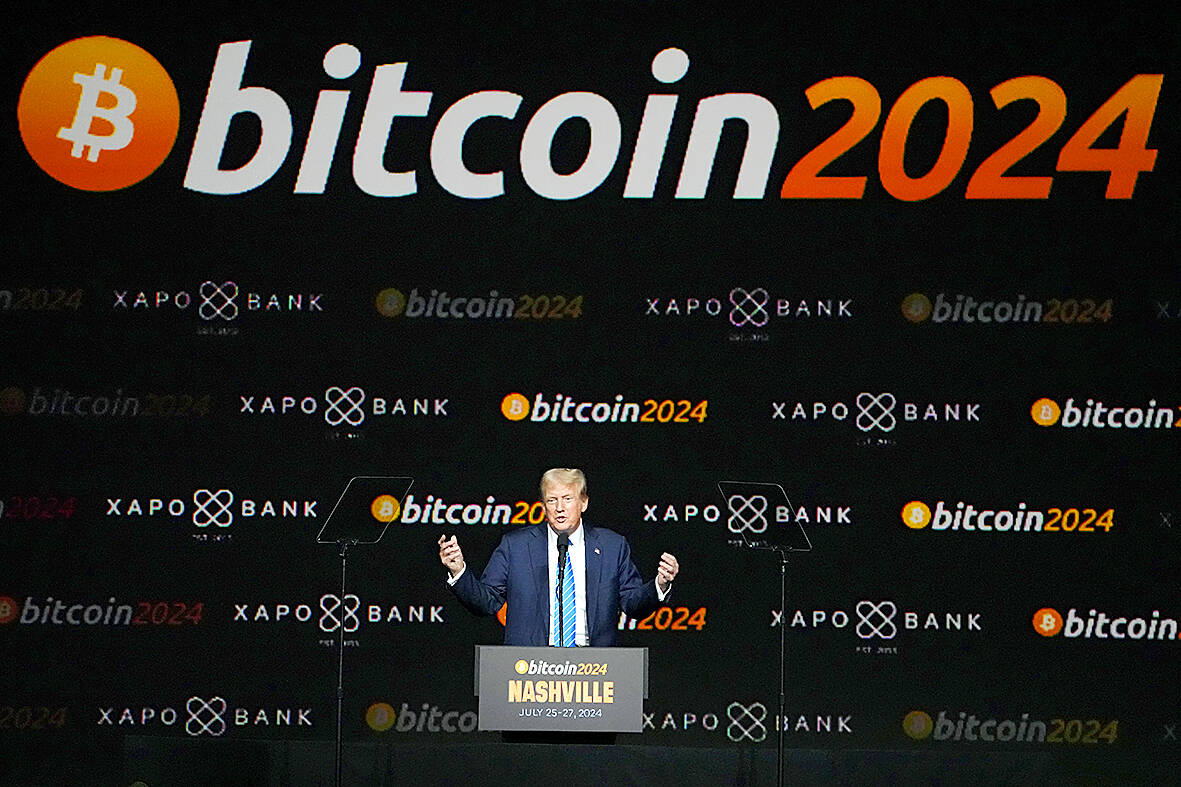Bitcoin topped US$100,000 for the first time this week as a massive rally in the world’s most popular cryptocurrency, largely accelerated by the election of Donald Trump, rolls on.
The cryptocurrency officially rose six figures Wednesday night, just hours after the president-elect said he intends to nominate cryptocurrency advocate Paul Atkins to be the next chair of the Securities and Exchange Commission.
Bitcoin has soared since Trump won the US presidential election on Nov. 5. The asset climbed from US$69,374 on Election Day, hitting as high as US$103,713 Wednesday, according to CoinDesk. And the latest all-time high arrives just two years after bitcoin dropped below US$17,000 following the collapse of crypto exchange FTX.

Photo: AP
Bitcoin fell back below the US$100,000 by Thursday afternoon, sitting above US$99,000 by 4 pm ET. Even amid a massive rally that has more than doubled the value of bitcoin this year, some experts continue to warn of investment risks around the asset, which has quite a volatile history.
Here’s what you need to know.
WHAT IS CRYPTOCURRENCY

Photo: AP
Cryptocurrency has been around for a while now. But chances are you’ve heard about it more and more over the last few years.
In basic terms, cryptocurrency is digital money. This kind of currency is designed to work through an online network without a central authority — meaning it’s typically not backed by any government or banking institution — and transactions get recorded with technology called a blockchain.
Bitcoin is the largest and oldest cryptocurrency, although other assets like ethereum, XRP, tether and dogecoin have also gained popularity over the years. Some investors see cryptocurrency as a “digital alternative” to traditional money, but most daily financial transactions are still conducted using fiat currencies such as the dollar. Also, bitcoin can be very volatile, with its price reliant on larger market conditions.

Photo: AP
WHY IS BITCOIN SOARING
A lot of the recent action has to do with the outcome of the US presidential election.
Trump, who was once a crypto skeptic, has pledged to make the US “the crypto capital of the planet” and create a “strategic reserve” of bitcoin. His campaign accepted donations in cryptocurrency and he courted fans at a bitcoin conference in July. He also launched World Liberty Financial, a new venture with family members to trade cryptocurrencies.
On Thursday morning, hours after bitcoin surpassed the US$100,000 mark, Trump congratulated “BITCOINERS” on his social media platform Truth Social. He also appeared to take credit for the recent rally, writing, “YOU’RE WELCOME!!!”
Top crypto players welcomed Trump’s election victory last month, in hopes that he would be able to push through legislative and regulatory changes that they’ve long lobbied for — which, generally speaking, aim for an increased sense of legitimacy without too much red tape. And the industry has made sizeable investments along the way. Back in August, Public Citizen, a left-leaning consumer rights advocacy nonprofit, reported finding that crypto-sector corporations spent more than US$119 million this year to back pro-crypto candidates across federal elections.
Trump made his latest pro-crypto move when he announced his plans Wednesday to nominate Atkins to chair the SEC. Atkins was an SEC commissioner during the presidency of George W. Bush. In the years since leaving the agency, Atkins has made the case against too much market regulation. He joined the Token Alliance, a cryptocurrency advocacy organization, in 2017.
Under current chair Gary Gensler, who will step down when Trump takes office, the SEC has cracked down on the crypto industry — penalizing a number of companies for violating securities laws. Gensler has also faced ample criticism from industry players in the process.
One crypto-friendly move the SEC did make under Gensler was the approval in January of spot bitcoin ETFs, or exchange trade funds, which allow investors to have a stake in bitcoin without directly buying it. The spot ETFs were the dominant driver of bitcoin’s price before Trump’s win — but, like much of the crypto’s recent momentum, saw record inflows postelection.
US$100K — COULD IT KEEP CLIMBING?
Bitcoin surpassing the coveted US$100,000 mark has left much of the crypto world buzzing.
“What we’re seeing isn’t just a rally — it’s a fundamental transformation of bitcoin’s place in the financial system,” Nathan McCauley, CEO and co-founder of crypto custodian Anchorage Digital, said in a statement — while pointing to the growth of who’s entering the market, particularly with rising institutional adoption.
Still, others note that the new heights of bitcoin’s price don’t necessarily mean the asset is going mainstream. The US$100,000 level is “merely a psychological factor and ultimately just a number,” Dan Coatsworth, investment analyst at British investment company AJ Bell, wrote in a Thursday commentary.
That being said, bitcoin could keep climbing to more and more all-time highs, particularly if Trump makes good on his promises for more crypto-friendly regulation once in office. If Trump actually makes a bitcoin reserve, for example, supply changes could also propel the price forward.
“It is hard to overstate the magnitude of the change in Washington’s attitude towards crypto post-election,” Matt Hougan, chief investment officer at Bitwise Asset Management, said via e-mail Thursday, reiterating that prices could keep rising if trends persist. “There is a lot more demand than there is supply, and that’s usually a pretty good recipe for success.”
Still, as with everything in the volatile cryptoverse, the future is never promised. Worldwide regulatory uncertainties and environmental concerns around bitcoin “mining” — the creation of new bitcoin, which consumes a lot of energy — are among factors that analysts like Coatsworth note could hamper future growth. And, as still a relatively young asset with a history of volatility, longer-term adoption has yet to be seen through.
IS IT TOO LATE TO INVEST?
Today’s excitement around bitcoin may make many who aren’t already in the space want to get in on the action. For those in a position to invest, Hougan says it’s not too late — noting that bitcoin is still early in its development and most institutional investors “still have zero exposure.”
At the same time, Hougan and others maintain that it’s important to tread cautiously and not bite off more than you can chew. Experts continue to stress caution around getting carried away with crypto “FOMO,” or the fear of missing out, especially for small-pocketed investors.
“A lot of people have got rich from the cryptocurrency soaring in value this year, but this high-risk asset isn’t suitable for everyone,” Coatsworth noted Thursday. “It’s volatile, unpredictable and is driven by speculation, none of which makes for a sleep-at-night investment.”
In short, history shows you can lose money in crypto as quickly as you’ve made it. Long-term price behavior relies on larger market conditions. Trading continues at all hours, every day.
Coatsworth points to recent research from the Bank for International Settlements, a Switzerland-based global organization of central banks, which found that about three-quarters of retail buyers on crypto exchange apps likely lost money on their bitcoin investments between 2015 and 2022.
At the start of the COVID-19 pandemic, bitcoin stood at just over US$5,000. Its price climbed to nearly US$69,000 by November 2021, during high demand for technology assets, but later crashed during an aggressive series of rate hikes by the Federal Reserve. And the late-2022 collapse of FTX significantly undermined confidence in crypto overall, with bitcoin falling below US$17,000.
Investors began returning in large numbers as inflation started to cool — and gains skyrocketed on the anticipation and then early success of spot ETFs, and again, now the post-election frenzy. But lighter regulation from the coming Trump administration could also mean less guardrails.

In the March 9 edition of the Taipei Times a piece by Ninon Godefroy ran with the headine “The quiet, gentle rhythm of Taiwan.” It started with the line “Taiwan is a small, humble place. There is no Eiffel Tower, no pyramids — no singular attraction that draws the world’s attention.” I laughed out loud at that. This was out of no disrespect for the author or the piece, which made some interesting analogies and good points about how both Din Tai Fung’s and Taiwan Semiconductor Manufacturing Co’s (TSMC, 台積電) meticulous attention to detail and quality are not quite up to

April 21 to April 27 Hsieh Er’s (謝娥) political fortunes were rising fast after she got out of jail and joined the Chinese Nationalist Party (KMT) in December 1945. Not only did she hold key positions in various committees, she was elected the only woman on the Taipei City Council and headed to Nanjing in 1946 as the sole Taiwanese female representative to the National Constituent Assembly. With the support of first lady Soong May-ling (宋美齡), she started the Taipei Women’s Association and Taiwan Provincial Women’s Association, where she

It is one of the more remarkable facts of Taiwan history that it was never occupied or claimed by any of the numerous kingdoms of southern China — Han or otherwise — that lay just across the water from it. None of their brilliant ministers ever discovered that Taiwan was a “core interest” of the state whose annexation was “inevitable.” As Paul Kua notes in an excellent monograph laying out how the Portuguese gave Taiwan the name “Formosa,” the first Europeans to express an interest in occupying Taiwan were the Spanish. Tonio Andrade in his seminal work, How Taiwan Became Chinese,

Mongolian influencer Anudari Daarya looks effortlessly glamorous and carefree in her social media posts — but the classically trained pianist’s road to acceptance as a transgender artist has been anything but easy. She is one of a growing number of Mongolian LGBTQ youth challenging stereotypes and fighting for acceptance through media representation in the socially conservative country. LGBTQ Mongolians often hide their identities from their employers and colleagues for fear of discrimination, with a survey by the non-profit LGBT Centre Mongolia showing that only 20 percent of people felt comfortable coming out at work. Daarya, 25, said she has faced discrimination since she